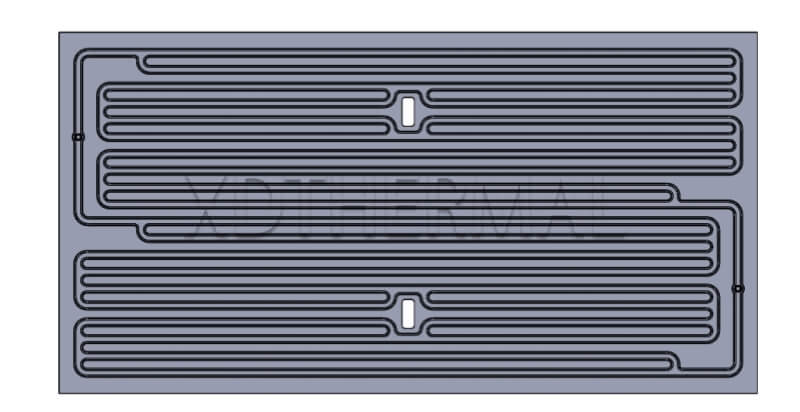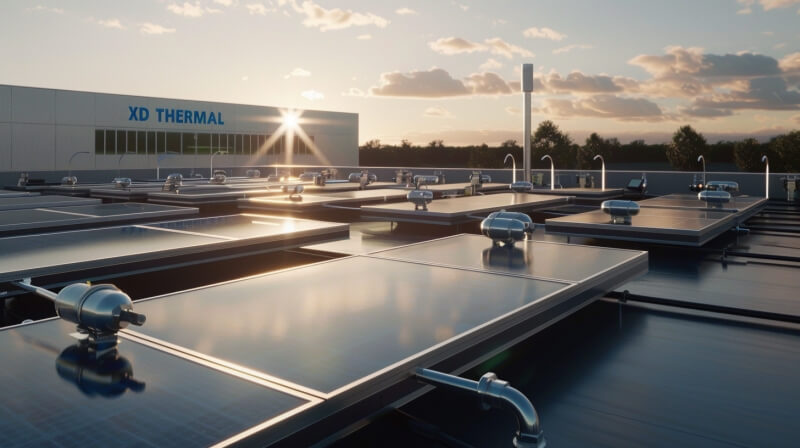Clients tell us their conventional PV strings stall under midday heat; liquid cooled PVT panels keep cells near 40 °C and turn that excess warmth into 60–80 °C hot water. For space-tight rooftops or fast payback projects—especially with custom plates from XD THERMAL—the upgrade is a clear win.
In this article, I’ll walk you through what these cooling plates are, how they work, their technical specs, the benefits they offer, real-world applications, and even the challenges and future trends we should keep an eye on – all in a clear, approachable style. Let’s dive in!
So, what exactly are these PVT cooling plates I keep mentioning? In plain terms, they are specialized components designed to enhance a solar panel’s performance by tackling its biggest inefficiency: waste heat. To put it in perspective, a typical photovoltaic (PV) panel only converts about 15–20% of sunlight into electricity, while roughly 65–70% of the solar energy becomes heat that just warms up the panel. That’s a huge amount of potential energy that traditional panels don’t use! By adding a cooling plate and liquid circulation, a PV panel essentially becomes a liquid cooled PV/T collector, meaning it can produce useful thermal energy alongside electricity instead of letting that heat go to waste.
How they’re built:
These plates are usually made of highly conductive materials like aluminum or copper (materials prized for carrying heat away quickly). They attach snugly to the back of a PV module or are sometimes integrated directly during manufacturing. Inside the plate, you have a network of channels or tubing through which a fluid—often water or a water-glycol mixture—flows. As the fluid runs through, it absorbs heat from the panel. The result is a hybrid panel that now yields two forms of energy: electrical power from the PV cells and thermal energy carried by the heated liquid.

Key Features:
● Materials – High thermal conductivity metals (usually aluminum or copper) to ensure efficient heat transfer.
● Design – Built-in channels or pipes for liquid circulation, custom-fitted to the panel’s size and shape.
● Purpose – Keep PV cell temperatures lower (for better electrical efficiency) while capturing heat for practical use (like heating water or air).
In short, a PVT cooling plate turns a regular solar panel into a multitasking unit that supplies both electricity and usable heat.
Every degree above 25 °C robs silicon cells of roughly 0.4 % of their output, and in hot regions panels routinely soar past 70 °C. Left unchecked, that heat slashes annual yield and ages laminates faster than finance models assume.
Actively cooling a PV/T collector with water or nanofluid recovers 8-15 % electricity and captures up to 70 % of incident solar energy as usable heat.
In a 2025 Saudi trial, uncovered modules hit 78 °C, chopping electrical efficiency by 12 %. Retrofitting a water loop cut surface temperature to 43 °C and boosted total system energy by 68 %. A graphene-nanofluid pilot in India pushed electrical gains to 11 % and thermal efficiency to 67 % . Cooling also halves so-called “hot-spot” stress, extending module life by several years.
Now that we know why heat is the enemy, let’s zoom in on the hardware that defeats it: a thin, high conductivity metal plate—etched or milled with flow channels and bonded tight behind the cells.
As coolant sweeps through serpentine or microchannels, the water cooled photovoltaic thermal plate draws heat into the liquid at 15–20 × the rate of natural air convection, keeping the panel cool while delivering 60–80 °C outlet fluid.

As solar cells generate electricity, they also produce heat—each degree of temperature rise can reduce efficiency by 0.2–0.5%. The cooling plate absorbs this excess heat via a circulating liquid (water, glycol mix, or other coolants), acting as a PV/T heat exchanger. The warmed fluid then moves through a closed-loop circuit, transferring heat to a storage tank, building heating system, or even an absorption chiller.
Cooling plates are either bonded to PV modules using thermal adhesive or built in as integrated units. A closed-loop system with a pump ensures continuous circulation, minimal fluid loss, and efficient heat transfer. Flow rates are carefully controlled to balance heat pickup and pressure drop.
By keeping cells cooler, electrical efficiency can reach up to ~17.8%, especially in hot climates. Meanwhile, thermal efficiency ranges between 70–76%, often making heat the dominant energy output. This dual production of electricity and usable heat maximises energy yield from the same surface area—ideal for rooftops or compact installations.
Think of the plate as a microchannel cold plate for solar. Copper offers 390 W m-¹ K-¹ conductivity but costs more; aluminium’s 205 W m-¹ K-¹ still outperforms stainless steel at one-third the mass. Channel topologies matter: sheet-and-tube (HTC ≈ 3 kW m-² K-¹), serpentine (≈ 5 kW m-² K-¹) and micro-channel (≈ 10 kW m-² K-¹). A recent CFD study showed a double layer micro-channel heat sink holding PV cells below 42 °C at 1000 W m-² irradiance while pumping only 0.1 bar (Nature). The plate therefore performs double duty: it is both a structural back sheet and an on-panel PV/T heat exchanger plate.
Designing a high performance liquid cooled PV/T collector means juggling plate metal, channel geometry and coolant chemistry.
Aluminium plates with 0.8 mm micro-channels, fed by graphene-water nanofluid at 0.2 wt %, delivered 20 % higher heat transfer coefficient than plain water in 2025 bench tests.
Phase change material (PCM) layers welded under the plate flatten temperature spikes, raising combined efficiency to 82–85 % in 2024 European prototypes (ScienceDirect). DualSun’s commercial SPRING4 module pairs an aluminium plate and water loop, touting six to eight times the total energy of a same size PV panel.
From our clients’ project audits, the hybrid payoff shows up in three columns: power yield, thermal savings and roof-space efficiency.
Field data indicate 8–12 % more electricity, 900–950 W th per panel, and levelised cost of energy cuts of 8–12 % versus stand-alone PV plus flat plate thermal.
✅ Electricity: Cooler cells sustain near STC efficiency through peak sun, adding 70–100 kWh kWp⁻¹ yr⁻¹ in hot climates.
✅ Heat: A 40-panel hotel roof in Spain now heats 2 000 L day⁻¹ domestic hot water at 60 °C, chopping gas use 32 %.
✅ Footprint: One hybrid panel frees roof area otherwise split between PV and thermal gear—critical on high rise or mobile installations.
✅ Carbon: A Finnish district energy pilot logged 35 t CO₂-e avoided over 25 years by swapping gas boilers for water cooled photovoltaic thermal supply.
I’ve seen hybrid arrays thrive from dairies to data centres—anywhere simultaneous heat and power make sense. By combining electricity generation with thermal output in one compact system, liquid-cooled PVT panels maximise roof utilisation, boost PV efficiency by 8–12% in hot climates, and reduce water consumption through closed-loop designs. Built with recyclable materials, they align well with sustainability goals, while offering reliable performance across diverse climates.
Commercial rooftops, industrial process-heat sites, swimming pools and agrivoltaic farms top the adopter list, with payback windows from 3 to 7 years.
● Industrial: A Chilean dairy replaced LPG pasteurisers with a 500 m² liquid cooled field, saving €34 000 annually.
● Hospitality: Resorts on Greek islands pair liquid cooled PVT panels with heat pumps, covering 80 % of hot-water load while trimming grid draw at noon.
● Agrivoltaics: Cooler panels lower underside temps, improving crop yield while irrigation taps pre-heated water.
● IT: A Tokyo colocation centre couples roof PVT loops to rear-door exchanger racks, shaving chiller energy 6 %.

Liquid loops move 50–60 × more heat per unit volume than forced air and unlock thermal energy you can monetise; passive fins cannot.
Air convection coefficients cap at ~50 W m-² K-¹; water in micro-channels hits 10 000 W m-² K-¹. That’s why air cooled add-ons rarely cut panel temps below ambient + 15 °C under strong sun. Meanwhile, pumped liquid cooling adds < 1 % parasitic load and transforms waste heat into revenue streams— impossible with fan-only rigs. Still, an air solution may suit off-grid cabins where plumbing is impractical.
No technology is bulletproof; here are the gremlins I watch for in owner engineering reviews.
Scaling, leaks, glycol ageing and sub-optimal flow distribution can erode gains, but smart monitoring holds OPEX low.
Scaling adds 0.1 K W⁻¹ m² after two years in hard water regions; inline de-ionisers and 5 µm filters halve deposition. Ethylene glycol mixes guard against freeze but cut specific heat 15 %. Pump energy at 0.1 bar drop equals 0.5 % of annual PV yield—budget for it. Sensor fed digital twins now flag fouling before efficiency slips below 95 % (ScienceDirect).
Even the most efficient hybrid system has its weak spots. If left unchecked, small design oversights or poor maintenance can gradually eat into your performance gains.
Scaling, leaks, coolant ageing, and uneven flow are the top culprits that reduce long-term efficiency—but proactive monitoring and timely fluid replacement can keep systems running at over 95% output.
Hard-water scaling alone can add 0.1 K W⁻¹ m² after two years, especially in regions without pre-treatment. Installing inline deionisers and 5 µm filters can halve this buildup. Leaks and pressure drops also matter—every 0.1 bar lost through pumps equals roughly 0.5% of your annual PV output.
The coolant itself isn’t a “set and forget” element. Deionised water lasts 3–5 years, while glycol- or nanofluid-based systems need testing and top-ups every 24 months. One survey of 62 commercial arrays found coolant conductivity exceeded 30 µS/cm after four years, reducing thermal efficiency by 2%—but flushing restored 98% of performance. Advanced systems now use digital twins to detect fouling before it cuts into performance.
In short, a well-designed PVT system still needs smart maintenance. Ignore the liquid loop, and you’ll watch your energy savings quietly slip away.
he R&D pipeline brims with tweaks that promise to push combined efficiency past 85 % by 2030.
Additively manufactured lattice plates, graphene ionanofluids and PCM-coupled hybrids headline 2024–25 journals, nudging total yields ever higher.
Nanofluid pioneers report 22 % HTC boosts with 0.3 vol % graphene nanoplatelets. PCM sandwiched plates in Malaysia maintained outlet water 12 °C cooler during peak cloud bursts (ScienceDirect). EU Horizon projects eye roll-to-roll aluminium graphene foils at €12 m-², while AI-optimised channel paths cut pressure drop 18 %. High temp stable fluids could soon raise outlet temps above 100 °C for light industrial steam.
PVT liquid cooling plates are a game-changer for solar energy systems. They let us boost the electrical output of PV panels by keeping them cool, while also capturing a ton of thermal energy that would otherwise be wasted. For manufacturers, engineers, and sustainability-minded project developers, this means an opportunity to deliver more efficient, versatile solar solutions that squeeze much more value out of every panel installed.
We’ve gone through how these plates work, their benefits, and even their challenges. The takeaway is that by adopting hybrid PV/T technology, a solar installation can provide two forms of energy from the same footprint, improving overall system ROI and sustainability. As ongoing research drives costs down and performance up, I anticipate PVT systems will play an increasingly important role in the renewable energy landscape.